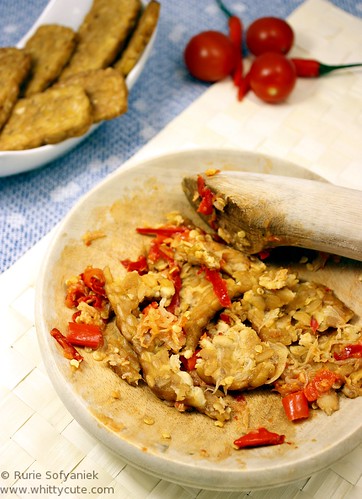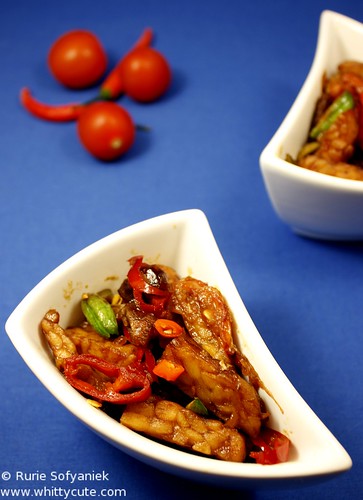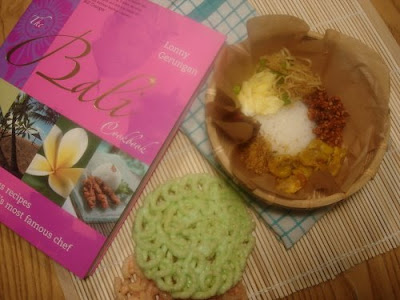|
|
I don’t know what my life would be without sambal. Maybe it would be bland and not interesting 😉 In Indonesia we have many kinds of sambal, it’s more than fingers in our hands I think 😉 here is one of my favorite. 
For 4 persons
Ingredients:
– 1 block of tempe., cut then deep fried
– 1 red chili
– 3 bird’s eye chili (more or less depending on your taste buds)
– 2 cm lesser galangal
– Salt
Directions:
– Pound all the spices except tempe with a pestle and mortar.
– Mash fried tempe on top of the sambal.
– Serve with steamed white rice.
Source: My mother
When I was still living in Indonesia, tempe wasn’t my favorite food. Maybe because it was too common and you could find it easily. But now I’m loving every bite of my tempe and would try to get any opportunity to cook and eat tempe 🙂

Ingredients:
– 1 block of tempe, cut like small stick, fried half done
– 10 shallots, sliced thinly
– 4 garlic, sliced thinly
– 5 red chili, sliced diagonally
– 5 green chili, sliced diagonally
– 1 tomato, diced
– 1 salam leaf
– 1 cm galangal, bruised
– 1 tbs oyster sauce
– 1/2 tbs kecap manis (Indonesian soy sauce)
– 1/2 tbs palm sugar
– 1-2 tsp tamarind water
– Salt
– 1-2 tbs oil
Directions:
– Heat oil in a skillet, add shallot and garlic, fry until fragrant.
– Add galangal and salam leaf, continue frying.
– Add tempe, stir well.
– Add tomato, kecap manis, tamarind water, palm sugar and salt.
– Continue cooking until water has evaporated, adjust the taste into your liking.
– Add green and red chili.
– Continue cooking just until the chilies are slightly wilted.
– Serve with hot steamed rice.
Source: Herti’s Kitchen
People, is it tom yum kung or tom yum goong? I need some “pencerahan”. Because when I ask “mbah” Google, both those two names showed up.
This month’s theme for masbar is tom yum kung, one soup dish from Thailand. Nowadays Thai food can be considered as equally famous as other famous Asian cuisine; Chinese and Indian food. When will Indonesian food can be as famous as them?
I was too lazy to google for other recipe so when Deetha said she had one, I immediately copied that…hehe. With some modification as I didn’t have some of the ingredients listed.
So here we go.

For 2 persons
Ingredients:
– 600 ml water
– 100 g shrimps/prawns, shelled, and deveined
– 2 garlic cloves, minced
– 3 kaffir lime leaves (bai-ma-krut)
– 3 thin slices fresh or dried galangal (kha)
– ¼ cup fish sauce (nam pla)
– 2 stalks lemon glass/cironella (ta-khrai), lower 1/3 portion only, cut into 1-in (2,3 cm) lengths
– 2 green onions, sliced
– 5 hot green Thai chilli peppers (phrik khi nu), optional
– ½ cup sliced shitakee mushrooms
– 60 ml lime juice
– 1 tablespoon chopped cilantro/coriander leaves (bai phak chi)
Directions:
– Bring the stock to a boil over medium heat.
– Add the garlic, lime leaves, galangal, fish sauce, lemon grass, and shallots, then the mushrooms and chili peppers, if using.
– Simmer for 2 minutes.
– Add the shrimp and reheat to boiling.
– Cook until the shrimps are pink, opaque, and firm but no longer than 1 minute.
– When the shrimps are cooked, place the lime juice and chili paste in a serving bowl.
– Pour the soup into the bowl, stir, and garnish with cilantro leaves.
Source: Adapted from book Amazing Tastes of Thailand through Deetha
PS: Don’t forget to participate in my foodie event 😀
Nothing beats nice hot soup for a cold day…but I don’t really fancy those smooth western soup…..ooh forgive my village taste buds alias lidah ndeso ini.

For 4 persons
Ingredients:
– Some chicken bone boiled in water to make 1 liter of chicken broth
– 4 bakso (Indonesian meatballs) sliced into 4
– 4 ready made fried tofu sliced into 2
– 100gr carrots, cleaned and cut
– 100gr cauliflower, cut into florets
– 100gr snow peas, trimmed
– 1 spring onion, sliced
– 5 stalk celery, sliced
– 3 shallots sliced
– 3 garlic sliced
– Grated nutmeg
– Salt
– Pepper
– Some oil
– Fried shallots
Directions:
– Heat the chicken broth in a deep pan.
– Heat oil in a pan, fry shallots and garlic until fragrant.
– Add the fried shallots and garlic to the chicken broth when it’s boiled.
– Lower the fire, add grated nutmeg, salt and pepper.
– Add carrots and cauliflower, cook for 3 minutes.
– Add snow peas, spring onion and celery, cook further until all vegetable is done (approx 2-3 minutes)
– Serve hot with fried shallots.
PS: You can eat it with rice or even with bread 😀
Source: My mother
If I freely translated this dish name’s into English, then it would be “Smashed Tofu” :p Yeah I have to admit I’m no good in translating food title. But if I try to describe it then it would be fried tofu crushed with sambal….hmm and nothing beats this with steamed white rice…and you have to use your hand when eating this 😉

Serve: 2 persons
Ingredients:
For the tofu
– 1 block of tofu cut as you like
– 1/2 tsp ground coriander
– 2 garlic mashed
– 1/2 tsp salt
– Some water
– Oil for frying
Directions:
– Put the water in a bowl, add ground coriander, garlic, salt.
– Add tofu and marinade for some time.
– Heat up the oil in a pan, fry tofu until golden brown.
Ingredients:
For the sambal
– 3 shallots
– 2 garlic
– 1 red chili cut
– 3 bird’s eye chili (more or less depending on your taste buds)
– 1 tomato cut
– 1/2 tsp salt
– 1/2 tsp sugar
– 1/2 tsp toasted terasi (shrimp paste)
– Little bit of oil
Directions:
– Fry the oil in a pan, when it’s hot add shallots, garlic, red chili, bird’s eye chili and tomato.
– Fry until they are a little bit dry.
– Grind them with the rest of the ingredients in a pestle and mortar.
– Crush the fried tofu with the sambal.
Source: Adapted from my mother
One of well known Indonesian food 🙂 and also one of my favorites. And why we call it Sate Ayam Madura? It’s because the seller of sate ayam are usually comes from Madura, it’s a little island north of Java island. That island is also happens to be where the grandparents from my father side came from. But boy I’m glad my father wasn’t a sate seller 😀 hihihi…

For 2-3 persons
Ingredients:
– Chicken meat from 1 thigh (as it is more juicier) , cubed and arrange in sate skewers
– Kecap manis (Indonesian sweet soy sauce)
– Shallots diced
– Bird’s eye chili minced
– Kaffir lime
– Lontong (pressed rice)
Directions:
– Take some peanut sauce and thin it little bit with kecap manis.
– Dip the sate in the peanut sauce until all cover with the sauce.
– Grill until sate is done.
– Serve with peanut sauce, diced shallots, minced bird’s eye chili, lontong (pressed rice).
– Squeeze kaffir lime over the sate.
Peanut sauce:
– 200gr fried peanuts grind in a food processor
– 3 garlic
– 1 red chili
– 3 candlenuts
– Kecap manis
– Salt
– Some oil
– Water
Directions:
– Grind garlic, candlenuts and red chili until smooth.
– Fry oil in a pan, fry spice mix until fragrant.
– Put the grind peanut in a pan, add water, salt and spice mix.
– Continue cooking until sauce is smooth, adjust water to get the consistency of your liking.
– Add kecap manis.
Source: My father
I was drooling over sate kambing pictures at Deetha’s blog, and was constantly thinking about it and that was also because we were talking about it nonstop at the YM. I have to say I was close to dream about it at night! Which mean I have to make it, otherwise I go crazy.
I smsed my mother asking for the recipe as there was no recipe at Deetha. My mother gave me the usual sate kambing recipe and also another recipe which she says was Maduranese from my father. The difference between the usual recipe and Maduranese recipe was that you just need to add little bit of petis (shrimp paste) in the spice mix. The verdict was that the petis gave a different tang of taste on the spice but I still also like the usual spice mix.

Ingredients:
– 500gr mutton cubed
– 3 garlic mashed
– Kecap manis (Indonesian sweet soy sauce)
– Kecap asin (soy sauce)
– Petis (optional)
Directions:
– Mix all ingredients in a bowl and marinade for couple of hours.
– Arrange the meat in a sate skewer (3 meats in one skewer).
– Grill sate until done.
Sambal Kecap
– 3 shallots, diced
– Kecap manis (Indonesian sweet soy sauce)
– Kecap asin (soy sauce)
– Juice of 1 lime
– 3 bird’s eye chili chopped (less or more according to your taste buds)
– Petis (optional)
Directions:
– Mix all ingredients in a bowl
I serve my sate kambing with sambal kecap, lontong (wrapped rice) and tongseng kambing.
Source: My mother
 Finally I got the chance to participate in Masbar event. It’s a monthly foodie blogger event which is organized by Ayin, Deetha and Shinta. There would be monthly theme that we could all try out and then the result should be up and about in your blog last Thursday every month, no time deadline. Eventhough the theme has been picked by them but it doesn’t mean you can’t improvise, you could use whatever recipe you like as long it represent the theme. Easy right? Finally I got the chance to participate in Masbar event. It’s a monthly foodie blogger event which is organized by Ayin, Deetha and Shinta. There would be monthly theme that we could all try out and then the result should be up and about in your blog last Thursday every month, no time deadline. Eventhough the theme has been picked by them but it doesn’t mean you can’t improvise, you could use whatever recipe you like as long it represent the theme. Easy right?
For this month we have got Pepes Ayam as theme. In English it’s a bit tricky to translate…hmm let’s see, how about “Steamed Chicken in Banana Leaves”. There are hundreds version of Pepes Ayam in Indonesia but because I used to live in Bali all of my life I chose to make Tum Ayam. Tum Ayam is indeed Balinese version of Pepes Ayam.
Since the spices used in making Tum Ayam were a lot, the taste was so rich of flavor, very Balinese indeed. The best way to eat it is when it’s just came out of the steamer, open the banana leaves, and some juice will burst out and never, I repeat never spill or throw that juice away because that is just the second best part after the chicken itself. Scoop some rice on the banana leaves and let the rice absorbs the juice. Eat with your hand…hmmmm…..can’t describe that with words….
PS: It is also nice to eat with Jukut Urap atawa nama lainnya Urap Sayur ala Bali
So enjoy the recipe and the picture everyone 🙂

Makes 20/serves 5-6 (Mine yield 10)
Ingredients:
– 1 shallot thinly sliced, deep fried until crispy
– 1 garlic clove thinly sliced, deep fried until crispy
– 2.5 tbs thick coconut milk
– 500 gr minced chicken (I used chicken pieces)
– salt
– 20 salam leaves (I used 10)
– 3 tbs vegetable oil
For the spice paste:
– 1/2 tsp roasted shrimp paste
– 1/2 tsp black peppercorn
– 2 shallots
– 3 garlic
– 1 long red chili
– 3 bird’s eye chillies
– 1.5 cm ginger
– 1.5 cm lesser galangal
– 1.5 cm turmeric
– 1 cm galangal
banana leaves washed and patted dry (I put my banana leaves couple of seconds on the fire to make them firmer and easier to be used)
bamboo strips or toothpicks
Directions:
– To make the spice paste, use a pestle and mortar (I used food processor) to pound all the spice paste ingredients into a paste.
– Heat oil in a wok add the spice paste and stir fry for about 3 minutes. Add the coconut milk and boil until all liquid has almost completely evaporated. Remove the wok from the heat and set aside.
– Mix the chicken with the spice paste, fried shallot, garlic and a little salt. Divide into 20 portions (mine was 10)
– Cut 20 pieces (mine was 10) pieces of banana leaves. Place 1 salam leave in a bottom of the leaf and top with the chicken mixture. Fold both sides of the leaf over the filling. Fold the open ends over and secure with a bamboo strips or toothpicks. Trim the empty ends at an angle to form a point at either end of the parcel.
– Put the parcels into a steamer, ensuring they rest above the water. Steam until cooked through about 25 minutes. Serve with white rice and jukut urap.
Source: The Bali Cookbook by Lonny Gerungan
This dish is a Balinese version of urap, urap itself is an Indonesian food consist of mixed vegetable with spices and coconut dressing. Now you can call this dish a sort of salad. It is really nice to accompany Tum Ayam which I would post tomorrow 🙂
What makes it different with urap from other part of Indonesia? I don’t know that much of urap myself but from my parents background (Javanese), when they make urap they always steam the dressing meaning the spices mixture and the coconut but in Bali, they always grill the coconut.
Now see the picture and maybe try the recipe, and you can see for yourself 😉

Serves 4-6
Ingredients:
– 100 gr bean sprouts, blanched
– 100 gr yard-long beans, cut and blanched
– 100 gr spinach, cut and blanched
– Flesh from one fresh coconut
– 1 cm fresh lesser galangal, finely chopped
– 1 tsp black peppercorn
– salt
– 2 kaffir lime leaves, very finely chopped
– 150 gr sambal mbe (see below)
– 1 tsp granulated sugar
– juice of 2 leprous limes (if unavailable, use kaffir limes)
Directions:
– Remove the dark skin from the coconut, toast the flesh over hot coals or under the grill until light brown, then grate it coarsely.
– Use a pestle and mortar to pound the lesser galangal with the peppercorns into a fine paste, then season with salt.
– Put the blanched vegetables into a serving dish and stir in the lime leaves, sambal mbe, sugar, lime juice, salt, coconut and spice paste.
Sambal Mbe
Ingredients:
– 1/2 tsp roasted dried shrimp
– salt
– 12-15 tbs coconut oil (I used vegetable oil since it was difficult to find coconut oil)
– 150 gr shallots, finely sliced
– 25 gr garlic, finely sliced
– 8 bird’s eye chillies sliced
– Juice of 2 leprous limes (if unavailable use kaffir limes)
Directions:
– Use a pestle and mortar to pound the shrimp paste and a little salt to a paste.
– Heat the coconut oil (I used vegetable oil) in a wok and deep fry the shallots and garlic separately until golden and crisp. Using a slotted spoon, transfer them to kitchen paper and leave to drain.
– Pour all but 2 tbs or the oil out of the wok, add the chillies and stir fry for about 2 minutes.
– Remove the wok from the heat and stir in the shallots, garlic, shrimp paste mixture and lime juice.
Source: The Bali Cookbook by Lonny Gerungan
 If you ever come to Bali or live in Bali, you must know this humble dish. It’s easy to find the seller esp. at night in the terrace of a closed shop or just in the sidewalk. Just with one table, a huge basket full of nasi jenggo, some mineral water and other soft drinks. Because they usually appear at night that’s why nasi jenggo is popular with youngster who likes to go out at night and also they who likes to get cheap night food. If you ever come to Bali or live in Bali, you must know this humble dish. It’s easy to find the seller esp. at night in the terrace of a closed shop or just in the sidewalk. Just with one table, a huge basket full of nasi jenggo, some mineral water and other soft drinks. Because they usually appear at night that’s why nasi jenggo is popular with youngster who likes to go out at night and also they who likes to get cheap night food.
Nasi jenggo usually wrapped in banana leaves, most of the time it contains a handful of white rice with some shredded chicken, omelette, dried coconut, fried noodle, dried tempe and sambal though other combination is possible but the most important element here is the sambal. It’s hot and sharp yet it’s so addictive. Because of the portion of nasi jenggo one adult could easily eat more than two nasi jenggo. Though nobody wanted to make a bigger portion of it as then I think it will ruin the beauty and the concept of nasi jenggo itself 😛
When I was small I could buy nasi jenggo for Rp. 100-200, but now I heard from some of my friends price has gone up to Rp. 1500-2500.
I have a really vivid memory of what sambal nasi jenggo should taste. But the recipe of the sambal here is not from a real nasi jenggo seller, it was from my mother, however I found the taste quite the same and could make up my craving for nasi jenggo.
My nasi jenggo consist of:
– handful of white rice (nasi putih)
– omelette (telor dadar)
– shredded chicken Balinese style (ayam pelalah)
– dried tempe (kering tempe)
– dried coconut (serundeng)
– fried noodle (mie goreng)
– sambal
Here I will share how to make some of the condiments as I know most of you might know already how to make for example easy omelette 😉
Ayam Pelalah (shredded chicken Balinese style)
– 500gr chicken meat preferably with skin as it is juicier, boiled and shredded
– 100ml chicken broth from the boiled chicken
– 6 shallots
– 4 garlic
– 1 cm lesser galangal
– 1 cm galangal
– 3 candlenuts
– 2 cm turmeric
– 3 bird’s eye chili or as desired
– 3 red chili or as desired
– 2 medium tomatoes
– 1 tsp dried shrimp (terasi)
– 2 tsp Indonesian palm sugar
– 1 tsp kaffir lime juice (or if you can’t find it just use normal lime juice)
– 1 stalk of lemongrass bruised
– 2 salam leaves
– 1/2 tsp salt
– some oil
Directions:
– Blend all spices ingredients except lime juice, lemongrass and salam leaves in a food processor or in a pestle and mortar until smooth.
– Heat up the oil in a pan, add the spice paste, lemongrass salam leaves and chicken broth.
– Fry until the spices is fragrant and done, add shredded chicken.
– Continue cooking until chicken is done meaning a little bit brown color and broth has evaporated.
– Pour the kaffir lime juice over the chicken.
Mie Goreng (Fried Noodle)
Ingredients:
– 200 gr of egg noodle cook according to package set aside, pour a little bit of oil on the noddle to prevent them from getting sticky
– 2 shallots sliced
– 2 garlic sliced
– 1 tsp sweet soy sauce
– 1 spring onion sliced
– salt
– pepper
– some oil
Directions:
– Heat up oil in a wok, when it’s hot add shallots and garlic.
– Fry until they are fragrant, add noodle and the rest of the ingredients, mix well.
– Continue cooking until noodle is done.
Sambal Nasi Jenggo
– 10 bird’s eye chili
– 3 shallots
– 1/2 tsp dried shrimp paste (terasi)
– salt
– sugar
– some oil
Directions:
– Blend all ingredients except oil in a food processor or pestle and mortar until smooth but not so smooth because you still want them to have a little bit of texture.
– Heat up oil in a pan, when it’s hot add the sambal, fry until sambal is fragrant and done.
PS: No, I didn’t get the recipe from that book in the picture, it was just a property 😉
|
Awards
 My First Award, Thank You!
My First Award, Thank You!
Whittycute Foodie Event
 Click here to see the round up!
Click here to see the round up!
|






